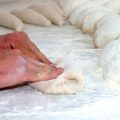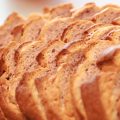Understanding bulk fermentation is essential, especially when it comes to sourdough baking. If you’re a new baker and aren’t quite familiar with the term, then you’re in luck! Appropriate bulk fermentation can help achieve the perfect airy crumb, and if this is what you want, then stick around for the super easy guide.
![Bulk Fermentation Sourdough, Explained! [Your Easy Guide] 1 Bulk fermentation sourdough explained [easy guide]](https://www.mydailysourdoughbread.com/wp-content/uploads/2023/01/CD-blog-images-2023-01-05T180351.135-720x405.jpg)
Table of Contents
- What is Bulk Fermentation?
- What to Do During Bulk Fermentation
- How Long Does Bulk Fermentation Last?
- How to Tell When Bulk Fermentation Has Finished
- If Your Under Proofed or Over Proofed Dough: What to Do
- When Does Bulk Fermentation Actually Begin
- Bulk Fermentation Sourdough
- Bulk Fermentation Sourdough – FAQs
What is Bulk Fermentation?
Bulk fermentation refers to the dough’s first resting period after mixing, dividing, and shaping. Bulk fermentation occurs at the end of mixing, and will last up until the dough needs to be divided and preshaped. The importance of bulk fermentation is fairly significant, because it helps the development of gluten strands, strengthening them so that they remain intact once the dough has been placed into the oven.
Bulk fermentation can last between 3-7 hours depending on the temperature of your dough. During this stage, you must keep a close eye on your dough. This is because you could risk over or under proofing your dough.
An over-proofed dough will collapse, deeming any chances of it being baked to perfection as futile. An under proofed sourdough will continue to rise once the crust sets in, resulting in a torn crust, which isn’t great at all.
Why is Bulk Fermentation Important?
The importance of bulk fermentation relies on the gases collected thanks to the sufficient gluten network in the dough.
The gluten network traps gases like carbon dioxide, which in turn causes the dough to rise and double in size, which also occurs once the dough is placed into the oven.
![Bulk Fermentation Sourdough, Explained! [Your Easy Guide] 2 Bulk fermentation sourdough explained [easy guide]](https://www.mydailysourdoughbread.com/wp-content/uploads/2023/01/CD-blog-images-2023-01-05T180406.105-720x405.jpg)
Can You Skip Bulk Fermentation?
Absolutely not!
If your dough doesn’t sit through bulk fermentation, it simply won’t rise. This results in a flat dough, with no structure, taste, or crust to impress.
Bulk fermentation is where amazing things happen to your dough. During bulk fermentation, the yeasts begin to thrive, and the yeasts work together in getting your dough to rise.
Skipping bulk fermentation will result in no rise or volume, resulting in sourdough bread emerging with an uneven crumb, and a gummy interior.
Keep in mind, that bulk fermentation must be completed. Otherwise, you might as well forget about putting your sourdough in the oven, as the results will be very disappointing!
What to Do During Bulk Fermentation
During bulk fermentation, you’ll need to perform six sets of stretches and folds to your dough, at 30-minute intervals.
The first 4 sets must be done with aggression, you don’t want to be gentle with your dough at all. Stretching and folding your dough is extremely important as it helps strengthen the dough so that there is no risk of the gluten strands tearing apart at any stage. As well as this, these sets enable you to regulate your dough’s temperature. While bulk fermentation requires some time, this enables us to continuously force some strength into the dough, without letting it rest uninterrupted.
Stretch and Fold
There are many ways to perform a standard stretch and fold, and it all comes down to what works for you.
Some of the chosen techniques are best for the specific shape of your bowl, and what works best when rotating the bowl upon each stretch and fold.
In addition, it all depends on the initial strength of your dough. If the dough is quite weak and slack, then you’ll need to be as robust and aggressive as you can with it.
However, if the dough is pretty strong, then gentle stretches and folds are preferred.
It may help to have a small bowl of water beside you, so that your hands and fingers don’t remain stuck to the dough, and ruin its structure. Use slightly wet hands to lift the dough, then stretch it up and fold it over to one side. Then rotate the bowl 180 degrees so that you’re looking at the opposite side, and repeat the above.
You should be left with a tube-shaped dough. Then rotate the bowl 90 degrees and stretch the dough once more. Finally, rotate the bowl 180 degrees and perform the final stretch and fold. You should have a neatly envelope-shaped dough in your bowl.
Cover the dough with a kitchen towel, or plastic wrap, and set an alarm for 30 minutes.
Regulate Dough Temperature
The bulk fermentation temperature will determine how long your dough will need to be bulk fermented. This is all part of the baking process, and the more you know, the better your dough and sourdough bread will be.
The temperature of your dough is separated into two separate entities, the final dough temperature (FDT) and the desired dough temperature (DDT).
Every ingredient used in your sourdough bread recipe has a unique temperature. While most of this cannot be controlled, we can manipulate our results with a splash of warm water, to adjust the temperature.
Simple adjustments like this will allow us to change the FDT of the dough. Realistically, a constant dough temperature will help you through the bulk fermentation stage, in the sense that it can determine how long your dough should be fermented before it’s time to bake sourdough bread.
For baking naturally leavened sourdough bread you will need a DDT of 75 degrees Fahrenheit to 82F.
However, if you’re working with whole wheat flour or any type of whole grains, then you should aim for an FDT of 75 degrees F, as the yeast and bacteria will be very active.
Consider the table below for reference:
| Final Dough Temperature | Estimated Duration of Bulk Fermentation |
| 75 degrees F | 4-4.5 hours |
| 78 degrees F | 4 hours |
| 80 degrees F | 3-3.5 hours |
How Long Does Bulk Fermentation Last?
Touching on our previous point, the length and duration of bulk fermentation will rely on the temperature of the dough.
Typically, bulk fermentation can last as little as 3 hours or up to 7 hours in total.
For overnight bakers, you may prefer to let your dough bulk ferment in the refrigerator, to slow down fermentation just enough for it to be ready for you in the morning.
How to Tell When Bulk Fermentation Has Finished
Understanding that your sourdough has completed bulk fermentation is essential.
One of the ways to tell is by gently shaking the bowl of dough. If the dough seems like it has been filled with gas enough to almost double in volume, then you can safely assume that it has completed bulk fermenting.
Here are some more ways to tell that your dough has finished proofing.
Signs That Your Dough Has Finished Proofing
One of the best ways to judge whether your dough has finished proofing is by pinching off a small piece of dough before bulk fermenting and placing it into a small glass. You can easily judge the status of your dough by checking whether the small piece of dough in the glass has doubled in size. Equally, your sourdough should have also doubled in its container.
Another sign that your dough has finished proofing is found out by gently pressing your fingertip into the top of the dough. If the dough springs back quickly, then your dough hasn’t finished proofing. However, if the dough springs back slowly, then this means that the dough is over-proofed.
Dough that springs back slowly, with a small indent of where your finger had been, signifies your bread dough is ready for the oven.
![Bulk Fermentation Sourdough, Explained! [Your Easy Guide] 4 Bulk fermentation](https://www.mydailysourdoughbread.com/wp-content/uploads/2023/01/CD-blog-images-2023-01-05T182122.376-720x405.jpg)
If Your Under Proofed or Over Proofed Dough: What to Do
Whether you’ve encountered the misfortune of under or over-proofed dough, there’s no reason to panic. Naturally, there are methods that will help fix this.
Under Proofed Dough
Under proofed dough can be fixed with additional resting time. Simply let the dough rest for as long as you deem fitting, before the final shape.
Over Proofed Dough
To fix over-proofed dough, simply remove the dough from its container, and gently but firmly, press down on the dough to degas it. Once the dough is void of air bubbles, you can get to reshaping the dough. Then place the reshaped dough back into its container and leave it to proof once again.
Always keep a close eye on your dough, as sometimes over-proofing can lead to disasters. You wouldn’t want your dough to expand so much until it bursts!
When Does Bulk Fermentation Actually Begin
Initially, we mentioned that bulk fermentation begins after mixing and forming the dough. Bulk fermentation is simply recognized as the next step in the process of baking sourdough.
However, truth be told, bulk fermentation actually begins from the moment you combine the sourdough starter with flour and water. This means that it begins as soon as you have gathered your ingredients, to mix the dough.
Bulk Fermentation Sourdough
Bulk fermentation is an essential step in sourdough baking. Without it, your sourdough bread won’t harbor the unique structure, perfect crumb, and extremely tender texture.
Understanding bulk fermentation will help you bake the perfect sourdough loaves each time!
If you’d like a reset in your baking, here’s my step by step beginners sourdough.
Bulk Fermentation Sourdough – FAQs
How Long Can I Bulk Ferment Sourdough?
You can bulk ferment your sourdough for 3 to 7 hours, depending on the temperature of the dough. At 78 degrees Fahrenheit, bulk fermentation usually lasts for 4-4.5 hours.
How do You Know When Sourdough Bulk Fermentation is Complete?
Once your sourdough has completed bulk fermentation it should have doubled in size, have a slightly domed surface, a smooth surface with bubbles forming, and feel light and airy.
Can You Bulk Ferment Sourdough Too Long?
No. It’s best to keep an eye on your dough during the last hour of bulk fermenting. If you were to bulk ferment your sourdough for too long, you may risk over-proofing your dough.
How Much Should Sourdough Rise Bulk Fermentation?
Your dough should rise till it has doubled in size, compared to what it was before bulk fermenting. Some bakers prefer to have their sourdough rise by 30-50%, although it must double to ensure you get lots of bubbles, which will help the dough rise and expand when baking.

![Bulk Fermentation Sourdough, Explained! [Your Easy Guide] 3 Lavatools javelin pro duo ambidextrous backlit professional digital instant read meat thermometer for kitchen, food cooking, grill, bbq, smoker, candy, home brewing, coffee, and oil deep frying](https://m.media-amazon.com/images/I/61fwvna0l2L._SL500_.jpg)





